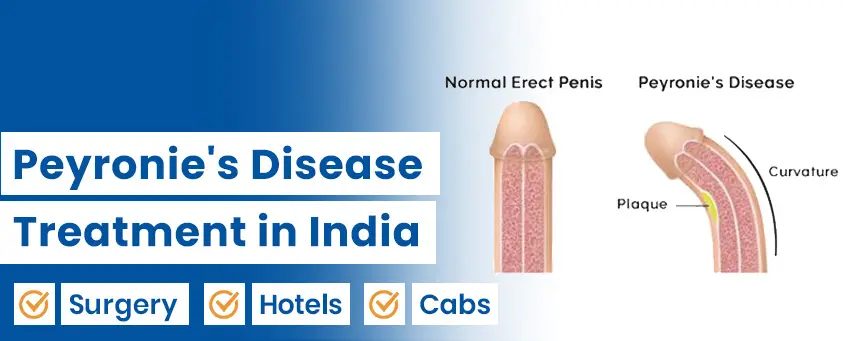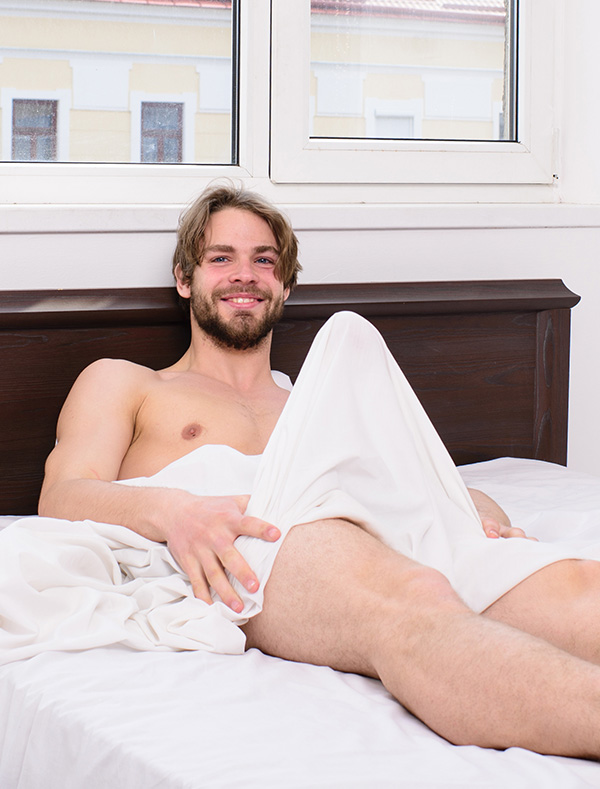

Africa’s healthcare system presents some of the most crucial problems regarding the available healthcare facilities. Only less than 50% of Africans can get proper treatment in a health facility today. Consequently, patients from Ethiopia, Uganda, Tanzania, and Rwanda are shifting towards other countries to seek medical treatments, including special services such as Peyronie’s disease treatment. India provides almost all kinds of equipment and highly technical medical facilities in cost-effective ways compared to Europe or the USA. The visa process is also straightforward. Approvals usually take one week and should hence be considered. Thus, due to the affordable addition of modern and affordable urology hospitals for peyronie treatment in India and the surgeon's expertise, India has become a preferred destination for African patients.
India has a pool of expert urologists exclusively practising for conditions related to the penis. The country excels in treating Peyronie’s disease, and several urologists report seeing 3-5 patients a day involving congenital penile curvature. Indian specialists apply advanced techniques like venous patch grafts to treat curvatures that develop by forming fibrotic bands or plaque. Also, patients get modern services for peyronie treatment in India at reasonable prices.
Peyronie's disease is characterised by the presence of scar tissue in the penis, which may cause it to become bowed, curved, or shorter and thinner. When the scar tissue forms, you may experience discomfort in a particular area of your penis. Your penis, when you get an erection, may bend upwards, downwards, or to the side, depending on the placement of any scars you may have. An indentation look is more common in males with this issue than a visible curvature. Most guys have erections that aren't completely straight. A little curvature of the penis does not always indicate Peyronie's disease. Peyronie's illness does not affect men with a lifelong curve.
As a general rule, Peyronie's disease will continue to progress in most men. When Peyronie's illness is left untreated, it seldom goes away. Early therapy may prevent the illness from worsening or improve symptoms if it is started soon after the onset. Even if you've suffered from the issue for a while, Peyronie's disease treatment could help reduce uncomfortable symptoms, including soreness, curvature, and shrinking of the penile shaft.
Peyronie's disease is still a mystery as to its exact cause. Most likely, it is caused by injury to tiny blood vessels, such as those seen in sex or sports, a blow, or a collision with a motor vehicle. Scar tissue may form if healing cells get stuck in the wound area. The two sponge-like tubes that make up the penis's corpus cavernosum may be found on either side. Caverns abound inside each of these tubes. Capillaries fill up with blood when a man is in a state of sexual arousal.

There are two stages involved in the progression of Peyronie's disease:
The shape of your penis begins to change. This phase, which may continue for up to 18 months, is characterised by plaque formation. In the course of this stage:
Once the plaque has been created, the process transitions into the chronic phase; in most cases, the chronic phase won't start until 12 to 18 months following the first manifestation of symptoms. In the course of this stage:
Peyronie's disease may present itself with the following signs and symptoms:
During any phase, a person may have difficulties with intercourse or ED. These may come on gradually or suddenly, and their severity may range from moderate to severe. Even though the curvature in the penis is still there, the discomfort will often improve with time in most instances.




The peyronie's disease treatment cost in India depends on several factors. Hospital charges include appointments before surgery, diagnostic tests, hospital bills, and charges by the surgeon. Peyronie's disease treatment in India encompasses nursing care, routine medication, and follow-up appointments as part of the plan. Also, India provides a wide range of care, including traction sessions, medications, and surgery such as suturing, excision and grafting, penile implants, and other therapies. Today, global patients can get quality peyronie treatment in India at a reasonable and accessible price. Thus, African people can get good care, services from experienced specialists, and affordable packages for penile straightening procedures. India has the medical workforce to treat patients successfully, and that also makes Peyronie's disease treatment costs cheaper than in other countries.
| Treatment | Cost in India | Stay in India |
|---|---|---|
| Peyronie's Disease Treatment in India | $2,500 | 7 Days |
A lot of people from many African countries like Tanzania, NIgeria and Cameroon visit India for Peyronie disease treatment. The Peyronie's disease treatment cost is much less than the cost in other countries. Indian hospitals have the most modern infrastructure and facilities, and their internationally-trained surgeons for peyronie's disease have years of experience and expertise in their particular field. For Peyronie's disease, treatments like traction therapy, medications, and surgery like suturing, excision and grafting, penile implants, and other treatments are available in India. The cost of Peyronie disease treatment in India is mentioned below.
Consult your physician about any past medical conditions or injuries. During the exam, your physician will use their hands to feel any areas of your body that have become rigid due to the condition. Some doctors may recommend that you have your testicles X-rayed or ultrasound. In certain cases, a doctor may inject medication to ensure the penis is erect during an exam.
While it's very unusual, doctors may do a biopsy if the doctor's examination does not establish Peyronie's disease if the problem worsens quickly. A small amount of tissue must be removed from the afflicted region for laboratory testing.
If you think you have Peyronie’s disease, contact a healthcare provider. The Peyronie's disease doctor will assess your medical history and physical state. The physical assessment checks the extent of the curve, the exact position of the plaques, and if there is pain. The doctor may palpate a flaccid penis to check for the presence of plaques or scar tissues. In some situations, the penis is examined during erection to measure the curvature to a higher degree of sensitivity.
Blood flow checks and plaque diagnostic studies by ultrasound are some of the necessary imaging tests. Ultrasound is also preferable for identifying the areas of scar tissue and assessing the blood flow. The doctor may also ask for pictures of the erect penis to determine the curvature and inform on how to approach curved pennis treatment. For some patients, using a questionnaire can be helpful in evaluating symptoms and treatment outcomes.
Early attendance is helpful in enhancing progression. Also, doctors here provide complete peyronie's disease treatment in India. Even though erectile dysfunction can also appear along with Peyronie’s, it doesn't showcase the disease. Also, a patient needs to do blood tests sometimes.
Peyronie's disease seems to be influenced by both genetics and advancing years. Some individuals are predisposed to the disease since it is hereditary and runs in families. As we get older, our tissues alter, making it easier to get injured and harder to recover. As a result, they are at an elevated risk of contracting the disease. There is a condition known as Dupuytren's contracture that causes your fingers to curl inward. Peyronie's disease is more likely to strike those who have Dupuytren's contracture, a condition that affects the connective tissues.
The medicines used in penile curvature treatment address the problem of penile curvature and other issues. The medication includes phosphodiesterase 5 inhibitors, L-arginine, and Vitamin E. The purpose of these drugs is to decrease inflammation and plaque formation. To date, only collagenase clostridium histolyticum (Xiaflex) has been approved by the FDA for treatment. It is suitable for adults with moderate and severe curves and lumps. This penile straightening treatment corrects the curve by degrading the collagen in the scar. Other methods include using verapamil to break down scar tissues and interferon, given its analgesic abilities.
Peyronie's disease treatment in India is most successful when started early on. Phosphodiesterase 5 inhibitors, L-arginine, and Vitamin E are some of the possible treatments. Inflammation and the formation of plaque are the primary goals of these drugs. Our doctors only use these medications rarely since better medical treatments are available and insufficient evidence supports their long-term usage.
Peyronie's disease treatment starts with increasingly prevalent injections. Before administering medicine, your penis will be numbed with lidocaine injections by healthcare professionals. Following the administration of the injection, your healthcare professional will apply a compression bandage to your penis to reduce the risk of swelling and bruising. You are free to take off the bandage three hours following your surgery. After your injection treatment, you can expect some bruises. Also, remember that you shouldn't have sex for 24 hours after the injection.
Peyronie's disease treatment might also include penile traction therapy. Many men follow their doctor's orders and do traction therapy at home for Peyronie's disease treatment. This technique aims to straighten the penis by gradually extending it. Because traction therapy devices may be worn securely under your clothing for prolonged periods, this treatment is simple to undertake on your own once our specialists assist you in selecting which device is right for you.
When the penile deformity is severe, surgical intervention is the only option. At the very least, you should give yourself at least a year before considering surgery for peyronie's disease treatment. The unaffected side can be shortened, penile implants can be implanted, and the scar tissue may be lengthened. Erectile dysfunction is more likely to occur when a man lengthens his penis. It's employed when the curvature is not as extreme.
The body produces the enzyme collagenase, which tears down scar tissue. An injection of the collagenase enzyme is an effective Peyronie's disease treatment. The Food and Medicine Administration has authorised this drug for the treatment of males with penises that are more than 30° curved.

Surgery may be a possibility if other Peyronie treatments aren't working. Among the most common procedures for peyronie's disease treatment in India are:

Plication surgery is yet another treatment that is popular for correcting peyronie’s disease for straightening severe penile curves. In the process, the doctors use saline or drugs to produce an artificial erection. The outer layer of the skin is peeled off, and the erections are corrected by sewing the excess tissue on one side. The final length depends on the side that is shorter where scarring of Peyronie’s disease exists. This Peyronie treatment is only advised when the curve has remained after 12 months and affects the intercourse. It is most appropriate in patients with good erectile function and a curvature degree of less than 60 degrees. Preoperative photographs of the erect penis may be required for the surgery. The outcomes of realignment have seen success ranging from 79% to 100%.
A penile prosthesis is the best treatment for Peyronie’s disease, especially where there is a residual curve after implantation. In the surgery, penile modelling can help to rectify the distortions by stretching the penis in the direct opposite of the deformity. In this study, dorsal or lateral curve patients are more suitable for using inflatable than malleable prostheses to improve their flattening curvature. The two-piece prosthesis consists of two cylinders and a pump. Also, an additional reservoir compounds the three-piece. This three-part structure provides greater satisfaction with a rigid and natural erection. Thus, penile prostheses are a sound choice for men needing advanced Peyronie's disease treatment in India.
The venous patch grafting technique is a unique Peyronie's disease treatment in India. This procedure starts with the circumcision incision at the dorsum of the penile shaft and extends close to the glans penis mass. Then, the surgeon removes all the skin and subcutaneous tissue down to the base of the penis.
In a dorsally situated plate, the deep dorsal vein is removed after the opening of the Buck’s fascia. Then, the surgeon separates the fascia and bilateral neurovascular bundles from the tunica albuginea. Surgical loupes prevent contact with the bundles and also ensure the bundles remain intact and of the required length. The autologous graft material is derived from the saphenous and dorsal veins. The graft helps to manage the curved shaft of the penis.
Peyronie's disease scar tissue can't be prevented or avoided since physicians don't know what causes it. If your father or sibling has the condition, you may be at greater risk of contracting it. This suggests that it may be hereditary. As you get older, you're more likely to encounter it. Having a connective tissue problem also raises your risk of having this illness.
If a mild pressure dressing is not removed within 24 to 48 hours following surgery, the recovery period may be slowed or even halted altogether. After the peyronie's disease treatment in India, you may continue to have a catheter in your bladder, which was inserted via your penis and into your bladder. When a patient is discharged from the hospital, the tube is usually removed from the care unit or the next morning. After the Peyronie treatment, you may be prescribed pain medication and medicines to help reduce inflammation and the likelihood of infection. For at least six weeks following surgery, you should avoid intercourse.


Suffering from Erectile Dysfunction
Open up and get treated
Semi Rigid and Inflatable Penile Implants
Get back the Erection
Insecure about your size
Get Penile Augmentation